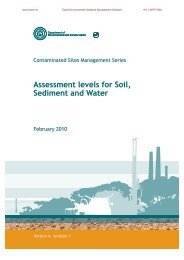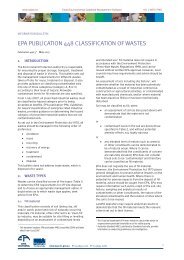Soil Generic Assessment Criteria for Human Health Risk ... - ESdat
Soil Generic Assessment Criteria for Human Health Risk ... - ESdat
Soil Generic Assessment Criteria for Human Health Risk ... - ESdat
Create successful ePaper yourself
Turn your PDF publications into a flip-book with our unique Google optimized e-Paper software.
www.esdat.net Esdat Environmental Database Management Software +61 2 8875 7948<br />
Molybdenum CAS Number: 7439-98-7 Assessor A: Nick Struggles, Assessor B: Atkins Final review: Penl/SF<br />
AECOM<br />
Date 01/06/2009 Date 17/06/2009 Date 26/08/2009<br />
Apply TDIoral to exposure routes<br />
Apply IDoral to exposure routes<br />
Apply TDIinh to exposure routes<br />
Apply IDinh to exposure routes<br />
Oral<br />
Inhalation<br />
Dermal<br />
Yes Yes No<br />
No No No<br />
No No Yes<br />
No No No<br />
Combine Oral Justification<br />
and Inhalation<br />
TDIs<br />
Insufficient data to assess non threshold effects - so<br />
HCV based on threshold effects. TDIoral applied to<br />
oral and dermal routes<br />
Yes<br />
Insufficient data to assess non threshold effects - so<br />
HCV based on threshold effects. TDIinhal applied to<br />
inhalation routes<br />
TDI oral<br />
Recommended<br />
TDIoral<br />
Units<br />
10 ug.kg-1.d-1<br />
Justification<br />
Recommended by EFSA and RIVM. Both studies are more recent than the USEPA (which had a lower value).<br />
Organisation Web Link Last Updated Date Web Checked <strong>Health</strong> criteria type Value Initial Units CLEA units ug.kg- Confidence rating Basis Value Units UF UF description Study type Description<br />
1.d-1<br />
European Food Safety Authority (EFSA) http://www.efsa.europa.eu/en.html 01/02/2006 01/06/2009 TDI oral 0.01 mg/kg bw/day 10 Medium NOAEL 0.9 mg/kg bw/day 100 10 <strong>for</strong> protecting sensitive human subpopulations<br />
9 week study of<br />
with inadequate<br />
Cu intake or with deficient Cu<br />
rats (diet and<br />
drinking water)<br />
metabolism in view of the species<br />
differences in antagonism between<br />
Mo and Cu, and another factor of 10<br />
to cover the lack of knowledge about<br />
reproductive effects of Mo<br />
in humans and incomplete data on the<br />
toxicokinetics in man.<br />
A tolerable upper intake level (UL) can be<br />
established using the 9-week study in the rat<br />
(Fungwe et al,<br />
1990).<br />
a) is the tolerable upper intake level<br />
b) is equivalent <strong>for</strong> adults<br />
5 groups, each of 21 female weaning rats, were<br />
given <strong>for</strong> 6 weeks a basic diet containing 0.025<br />
mg Mo/kg diet as well as 6.3 mg Cu/kg diet, and<br />
additionally in their drinking water doses of 0, 5,<br />
10, 50 and 100 mg Mo/L as sodium molybdate<br />
(Na2MoO4.2H2O) <strong>for</strong> 3 weeks until the 21st day<br />
of gestation. Six animals in each group were<br />
sacrificed after 6 weeks to determine the<br />
oestrus cycle length. The remaining 15 animals<br />
in each group were mated with untreated males<br />
and allowed to continue gestation <strong>for</strong> 21 days.<br />
WHO Guidelines <strong>for</strong> drinking water Quality<br />
http://www.who.int/water_sanitation_healt<br />
h/dwq/guidelines/en<br />
No data 01/06/2009 DW a) 0.07<br />
b) N/A<br />
c) N/A<br />
a) mg/L [Note<br />
Units]<br />
b) N/A<br />
a) 70<br />
b) N/A<br />
a) NOAEL<br />
b) N/A<br />
c) NOAEL<br />
a) 0.2<br />
b) N/A<br />
c) 2<br />
a) mg/L<br />
b) N/A<br />
c)<br />
mg/kg/bw/day<br />
a) 3<br />
b) N/A<br />
c) none provided<br />
a) Although an uncertainty factor of<br />
10 would normally be applied to<br />
reflect intraspecies variation, it is<br />
recognized that molybdenum is an<br />
essential element, and a factor of 3 is<br />
there<strong>for</strong>e considered to be adequate<br />
(provided in reference) (WHO)<br />
b) N/A<br />
c) None provided<br />
a) 2 year study of a) There are some concerns about the quality of<br />
humans exposed this study. This gives a guideline value of 0.07<br />
via drinking water mg/litre (rounded figure), which is in the same<br />
range as that derived on the basis of the results<br />
of toxicological studies in animals and is<br />
consistent with the essential daily requirement<br />
<strong>for</strong> molybdenum<br />
b) five pairs of Charles River CD mice received<br />
10mg of molybdenum per litre (about<br />
1.5mg/kg/bw/day) in deionised drinking-water<br />
<strong>for</strong> up to 6 months.<br />
c) The effects of dietary molybdenum on<br />
reproductive ability and pup growth during<br />
lactation were studied in Long-Evans rats fed<br />
diets containing 0.1, 2, 8, or 14 mg of<br />
molybdenum per kg of body weight per day and<br />
either 5 or 20 mg of copper per kg <strong>for</strong> 13 weeks<br />
(35).<br />
Dutch National Institute <strong>for</strong> Public <strong>Health</strong><br />
and the Environment (RIVM) Maximum<br />
Permissible <strong>Risk</strong> (MPR) levels.<br />
USEPA Integrated <strong>Risk</strong> In<strong>for</strong>mation System<br />
(IRIS)<br />
http://www.rivm.nl/en/ March 2001 01/06/2009 TDI 10 ug/kg/bw/day 10 Medium TDI oral (based<br />
on a NOAEL of<br />
1mg/kg as seen in<br />
rats)<br />
10 (TDIoral) ug/kg bw/day Considered adequate <strong>for</strong> intrahuman<br />
variation (RIVM)<br />
http://epa.gov/iris/<br />
28/10/2003 (based<br />
on 1961 study)<br />
01/06/2009 Oral RfD 0.005 mg.kg-1.d-1 5 Medium LOAEL 0.14 mg.kg-1.d-1 30 Quoted from IRIS. 3 <strong>for</strong> protection of<br />
sensitive human populations and a<br />
factor of 10 <strong>for</strong> the use of a LOAEL,<br />
rather than a NOAEL, from a longterm<br />
study in a human population. A<br />
full factor of 10 is not used <strong>for</strong> the<br />
protection of sensitive human<br />
populations because the study was<br />
conducted in a relatively large human<br />
population (IRIS)<br />
Chronic. <strong>Human</strong><br />
6-year to Lifetime<br />
dietary exposure<br />
study<br />
TDI of 10<br />
Koval'skiy, V.V., G.A. Yarovaya and D.M.<br />
Shmavonyan. 1961. Changes of purine<br />
metabolism in man and animals under<br />
conditions of molybdenum biogeochemical<br />
provinces. Zh. Obshch. Biol. 22:179-191.<br />
(Russian trans.)<br />
Notes to the value quoted: Dose determined<br />
from study: molybdenum (Mo) concentration in<br />
diet is 10-15 mg/day. Assumed body weight of<br />
adult male is 70 kg; 10 mg molybdenum/70-kg<br />
body weight = 0.14 mg/kg-day.<br />
Page 1 of 4 EIC pro<strong>for</strong>ma molybdenum.xls 26/08/2009








